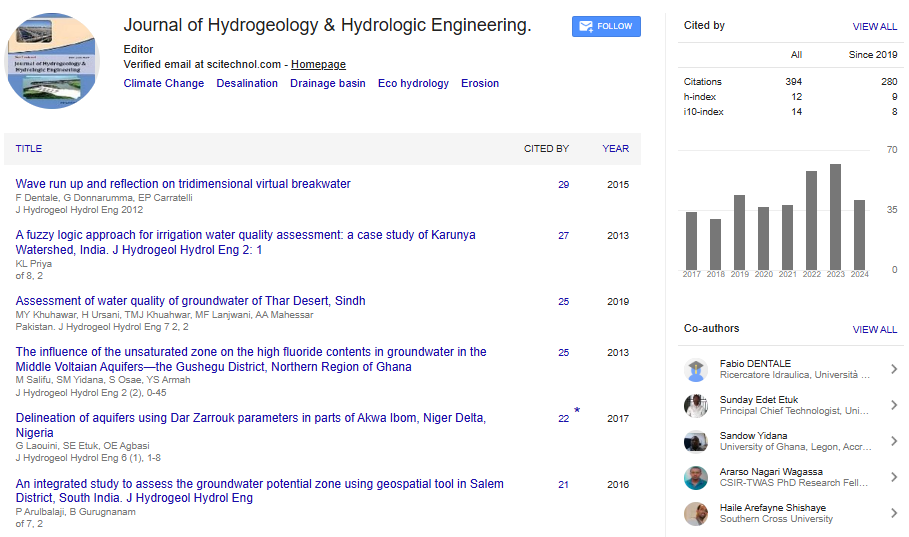Opinion Article, J Hydrogeol Hydrol Eng Vol: 13 Issue: 3
Recognizing Infiltration: Water's Path from Surface to Soil
Shikun Sun*
1Department of Civil & Environmental Engineering, Texas A&M University, College Station, USA
*Corresponding Author: Shikun Sun,
Department of Civil & Environmental
Engineering, Texas A&M University, College Station, USA
E-mail: sunshikun58@gmail.com
Received date: 27 May, 2024, Manuscript No. JHHE-24-144607;
Editor assigned date: 30 May, 2024, PreQC No. JHHE-24-144607 (PQ);
Reviewed date: 13 June, 2024, QC No. JHHE-24-144607;
Revised date: 21 June, 2024, Manuscript No. JHHE-24-144607 (R);
Published date: 28 June, 2024, DOI: 10.4172/2325-9647.1000327
Citation: Sun S (2024) Recognizing Infiltration: Water's Path from Surface to Soil. J Hydrogeol Hydrol Eng 13:3.
Description
Infiltration is a fundamental process in the hydrological cycle, playing an essential role in maintaining the balance of our ecosystem. It involves the movement of water from the ground surface into the soil, where it becomes available for plants, recharges groundwater, and supports various biogeochemical processes. This journey of water is essential for sustaining life on Earth and understanding it can help in managing water resources effectively. Infiltration begins when water from precipitation or irrigation reaches the ground surface. The rate at which water infiltrates depends on several factors, including soil type, soil moisture content, vegetation cover, and land use. For instance, sandy soils with larger particles have higher infiltration rates compared to clayey soils, which have smaller particles and can become compacted easily, reducing infiltration. The initial stage of infiltration is often rapid, especially if the soil is dry.
Factors influencing infiltration
The size and arrangement of soil particles affect infiltration. Sandy soils, with their larger pores, allow water to pass through more easily than clay soils, which have finer particles and smaller pore spaces. The pre-existing moisture level in the soil determines its capacity to absorb additional water. Dry soil can take in more water quickly compared to already wet soil. Plants and their root systems create pathways for water to infiltrate deeper into the soil. Additionally, vegetation protects the soil surface from the impact of raindrops, which can cause compaction and reduce infiltration. Urban areas with impervious surfaces like roads and buildings limit infiltration, leading to increased runoff. Agricultural practices, such as plowing and the use of cover crops, can either enhance or hinder infiltration depending on how they affect soil structure. Activities such as heavy machinery use in agriculture or construction can compact soil, reducing its infiltration capacity. Compacted soils have fewer large pores, which impedes water movement.
The importance of infiltration
Infiltrated water percolates down to recharge aquifers, which are vital sources of freshwater for drinking, irrigation, and industrial use. Water stored in the soil is available for plant uptake, essential for photosynthesis and growth. Healthy vegetation, in turn, supports a diverse ecosystem. Adequate infiltration helps maintain soil structure and prevents erosion. It also facilitates the movement of nutrients and organic matter, promoting soil fertility. By absorbing water, soil reduces surface runoff, which can help in mitigating floods. High infiltration rates can decrease the volume and speed of water flowing over the land, thus reducing the risk of flooding. Infiltration acts as a natural filter, removing pollutants and sediments from water as it moves through the soil layers. This process helps in maintaining the quality of groundwater and surface water bodies.
Enhancing infiltration
Practices like crop rotation, reduced tillage, and maintaining organic matter in the soil can improve its structure and increase infiltration rates. Planting cover crops, maintaining grasslands, and reforesting areas can enhance infiltration by protecting the soil surface and promoting root development. Designing urban areas with green spaces, permeable pavements, and rain gardens can help increase infiltration and reduce runoff. Limiting the use of heavy machinery on agricultural land and avoiding overgrazing can prevent soil compaction and maintain its infiltration capacity.
Conclusion
Infiltration is a vital process that supports the hydrological cycle, sustains ecosystems, and helps manage water resources. By understanding and promoting infiltration, we can enhance soil health, support plant growth, recharge groundwater, and mitigate the impacts of floods and water pollution. This is because dry soil has more pore spaces available to absorb water. As the soil becomes saturated, the infiltration rate decreases. This decline occurs due to the filling of pore spaces and the formation of a surface seal from fine particles clogging the pores. The infiltration capacity, which is the maximum rate at which soil can absorb water, is thus a dynamic parameter influenced by the soil's physical properties and environmental conditions.
 Spanish
Spanish  Chinese
Chinese  Russian
Russian  German
German  French
French  Japanese
Japanese  Portuguese
Portuguese  Hindi
Hindi 
